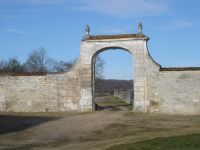You are here:
Abbeys > France > Burgundy > Tanlay > Quincy
Quincy
 The Cistercian abbey Notre Dame de Quincy, sixth daughter-house of Pontigny, was founded in 1133. Thanks to powerful donators such as Louis VI (The Fat), Louis VII, kings of France and Eudes II, Duke of Burgundy, the abbey was extremely successful and powerful making it, around a century after it was founded, one of the most important in France. The Cistercian church was consecrated in 1139. It was used as a necropolis for the Courtenay family, direct descendants of King Louis VII. The abbey owned fourteen granges, six or seven mills as well as wine cellars (Auxerre, Chablis, Epineuil). The hundred years' war, the religious wars and the Commendatory regime finally got the better of the monastery's prosperity. The first commendatory abbot (1560) was Odet de Coligny, brother of admiral Gaspard de Coligny and of Sir François d'Andelot owner of the château of Tanlay, rallying point of the Huguenot aristocracy. In 1568, d'Andelot ordered the Abbey of Quincy to be burned and the inhabitants to be massacred. Almost all the monks were killed and the fire devastated part of the monks building and the nave of the church. After that, the abbey lived only modestly. In 1791, the monastery was sold as a national asset and turned into a stone quarry. The abbey was bought in 1822 by the Marquis of Tanlay, owner of the château of Tanlay and it has remained in the same family since. Open to visits since 1999, all the buildings and gardens of the Abbey of Quincy are currently being restored. Yew trees are grown for the pharmacopeia and a labyrinth has been created by the artist Konrad Loder. With its three mills, in a typically Cistercian protected site, the Abbey of Quincy has managed to retain all its authenticity.
The Cistercian abbey Notre Dame de Quincy, sixth daughter-house of Pontigny, was founded in 1133. Thanks to powerful donators such as Louis VI (The Fat), Louis VII, kings of France and Eudes II, Duke of Burgundy, the abbey was extremely successful and powerful making it, around a century after it was founded, one of the most important in France. The Cistercian church was consecrated in 1139. It was used as a necropolis for the Courtenay family, direct descendants of King Louis VII. The abbey owned fourteen granges, six or seven mills as well as wine cellars (Auxerre, Chablis, Epineuil). The hundred years' war, the religious wars and the Commendatory regime finally got the better of the monastery's prosperity. The first commendatory abbot (1560) was Odet de Coligny, brother of admiral Gaspard de Coligny and of Sir François d'Andelot owner of the château of Tanlay, rallying point of the Huguenot aristocracy. In 1568, d'Andelot ordered the Abbey of Quincy to be burned and the inhabitants to be massacred. Almost all the monks were killed and the fire devastated part of the monks building and the nave of the church. After that, the abbey lived only modestly. In 1791, the monastery was sold as a national asset and turned into a stone quarry. The abbey was bought in 1822 by the Marquis of Tanlay, owner of the château of Tanlay and it has remained in the same family since. Open to visits since 1999, all the buildings and gardens of the Abbey of Quincy are currently being restored. Yew trees are grown for the pharmacopeia and a labyrinth has been created by the artist Konrad Loder. With its three mills, in a typically Cistercian protected site, the Abbey of Quincy has managed to retain all its authenticity. [ Back ]
